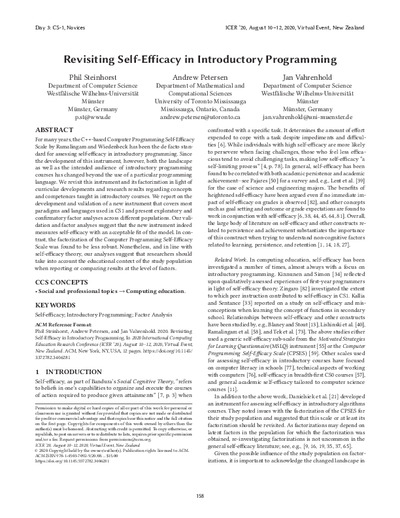Revisiting Self-Efficacy in Introductory Programming Publikationsdatum:
Zu finden in: ICER 2020 (Seite 158 bis 169), 2020
|
 |
 Diese Seite wurde seit 3 Jahren inhaltlich nicht mehr aktualisiert.
Unter Umständen ist sie nicht mehr aktuell.
Diese Seite wurde seit 3 Jahren inhaltlich nicht mehr aktualisiert.
Unter Umständen ist sie nicht mehr aktuell.
 Zusammenfassungen
Zusammenfassungen
For many years, the C++-based Computer Programming Self-Efficacy Scale by Ramalingam and Wiedenbeck has been the de facto standard for assessing self-efficacy in introductory programming. Since the development of this instrument, however, both the landscape as well as the intended audience of introductory programming courses has changed beyond the use of a particular programming language. We revisit this instrument and its factorization in light of curricular developments and research results regarding concepts and competences taught in introductory courses. We report on the development and validation of a new instrument that covers most paradigms and languages used in CS1 and present exploratory and confirmatory factor analyses across different populations. Our validation and factor analyses suggest that the new instrument indeed measures self-efficacy with an acceptable fit of the model. In contrast, the factorization of the Computer Programming Self-Efficacy Scale was found to be less robust. Nonetheless, and in line with self-efficacy theory, our analyses suggest that researchers should take into account the educational context of the study population when reporting or comparing results at the level of factors.
 Dieses Konferenz-Paper erwähnt ...
Dieses Konferenz-Paper erwähnt ...
 Personen KB IB clear | Jennifer M. Blaney , Dana B. Dahlstrom , Holger Danielsiek , Paul Denny , Daryl J. D'Souza , Benedict du Boulay , Richard J. Enbody , Shelly Engelman , Kathi Fisler , Jon Good , Mark Guzdial , John Hamer , Päivi Kinnunen , Peter Klemperer , Shriram Krishnamurthi , Alex Lishinski , Raymond Lister , Andrew Luxton-Reilly , John Monk , Tim O'Shea , Miranda C. Parker , Leo Porter , Helen C. Purchase , Judy Sheard , Beth Simon , Simon , Juha Sorva , Martijn Stegeman , Jane G. Stout , Grace Tan , Laura Toma , Jan Vahrenhold , Anne Venables , Aman Yadav , Daniel Zingaro | |||||||||||||||||||||||||||||||||||||||||||||||||||||||||||||||||||||||||||||||||||||||||||||||||||
 Begriffe KB IB clear |  Programmieren Programmieren programming
, Selbstwirksamkeitself efficacy programming
, Selbstwirksamkeitself efficacy
| |||||||||||||||||||||||||||||||||||||||||||||||||||||||||||||||||||||||||||||||||||||||||||||||||||
 Bücher |
| |||||||||||||||||||||||||||||||||||||||||||||||||||||||||||||||||||||||||||||||||||||||||||||||||||
 Texte |
|
 Zitationsgraph
Zitationsgraph
 Zitationsgraph (Beta-Test mit vis.js)
Zitationsgraph (Beta-Test mit vis.js)
 Zeitleiste
Zeitleiste
 1 Erwähnungen
1 Erwähnungen 
- WiPSCE '21 - The 16th Workshop in Primary and Secondary Computing Education, Virtual Event / Erlangen, Germany, October 18-20, 2021 (Marc Berges, Andraes Mühling, Michal Armoni) (2021)
- Investigating Teacher's Empathy and Its Impact on Pre-Service Teachers' Self-Efficacy in Programming Tasks (Bernhard Standl, Nadine Schlomske-Bodenstein) (2021)


- Investigating Teacher's Empathy and Its Impact on Pre-Service Teachers' Self-Efficacy in Programming Tasks (Bernhard Standl, Nadine Schlomske-Bodenstein) (2021)
 Anderswo finden
Anderswo finden
 Volltext dieses Dokuments
Volltext dieses Dokuments
 |  Revisiting Self-Efficacy in Introductory Programming: Fulltext at the ACM Digital Library ( Revisiting Self-Efficacy in Introductory Programming: Fulltext at the ACM Digital Library ( : :  , 763 kByte; , 763 kByte;  : :  ) ) |
 Anderswo suchen
Anderswo suchen 
 Beat und dieses Konferenz-Paper
Beat und dieses Konferenz-Paper
Beat hat Dieses Konferenz-Paper während seiner Zeit am Institut für Medien und Schule (IMS) ins Biblionetz aufgenommen. Beat besitzt kein physisches, aber ein digitales Exemplar. Eine digitale Version ist auf dem Internet verfügbar (s.o.). Es gibt bisher nur wenige Objekte im Biblionetz, die dieses Werk zitieren.



















 Biblionetz-History
Biblionetz-History